tow Lexus GX460 2014 Owner's Guide
[x] Cancel search | Manufacturer: LEXUS, Model Year: 2014, Model line: GX460, Model: Lexus GX460 2014Pages: 624, PDF Size: 19.39 MB
Page 165 of 624
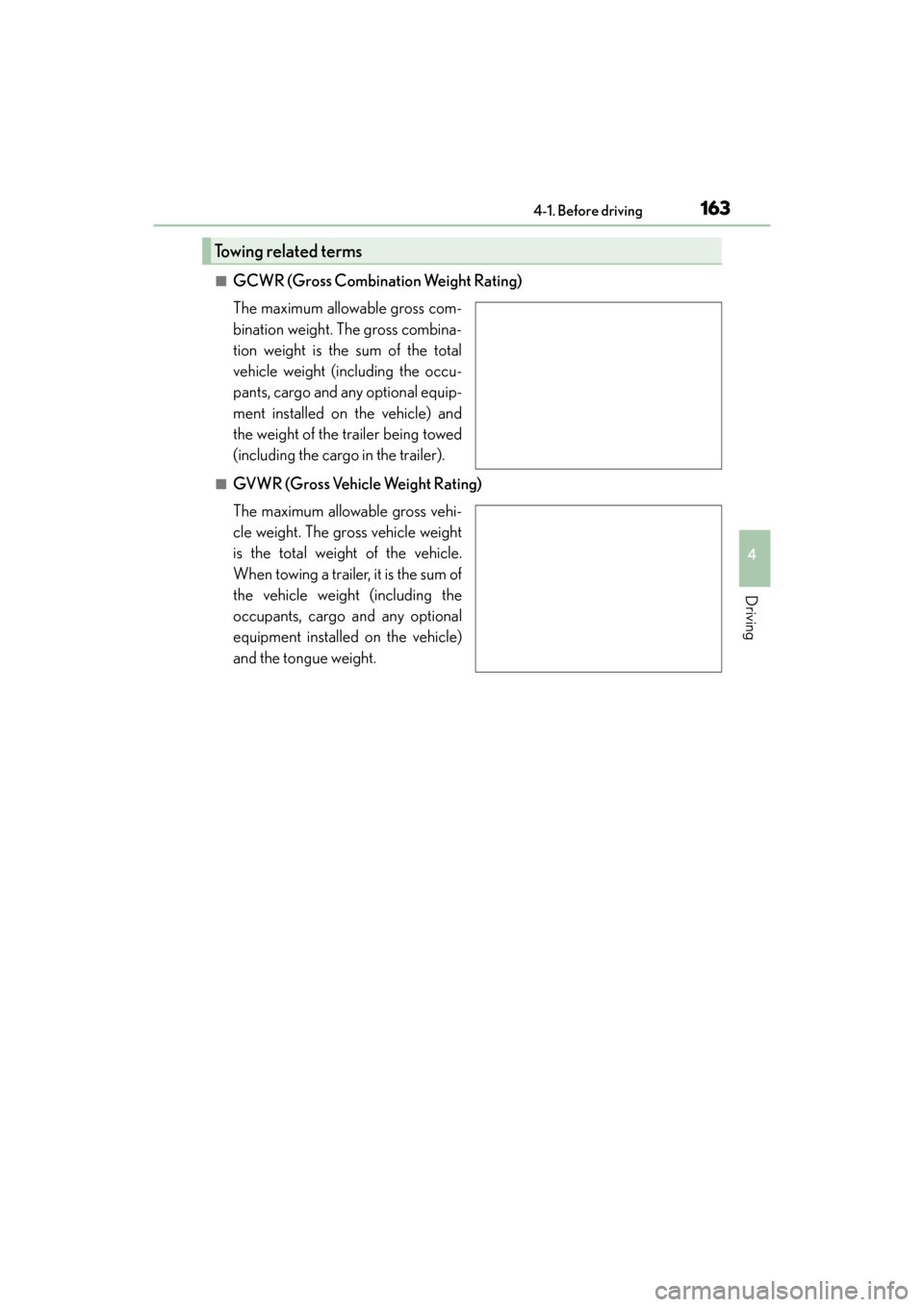
GX 460 _O M_ OM6 0K 80 U_ (U)
1634-1. Before driving
4
Driving
■GCWR (Gross Combination Weight Rating)
The maximum allowable gross com-
bination weight. The gross combina-
tion weight is the sum of the total
vehicle weight (including the occu-
pants, cargo and any optional equip-
ment installed on the vehicle) and
the weight of the trailer being towed
(including the cargo in the trailer).
■GVWR (Gross Vehicle Weight Rating)
The maximum allowable gross vehi-
cle weight. The gross vehicle weight
is the total weight of the vehicle.
When towing a trailer, it is the sum of
the vehicle weight (including the
occupants, cargo and any optional
equipment installed on the vehicle)
and the tongue weight.
Towing related terms
GX460_OM_OM60K80U_(U).book Page 163 Wednesday, July 3, 2013 11:40 AM
Page 166 of 624
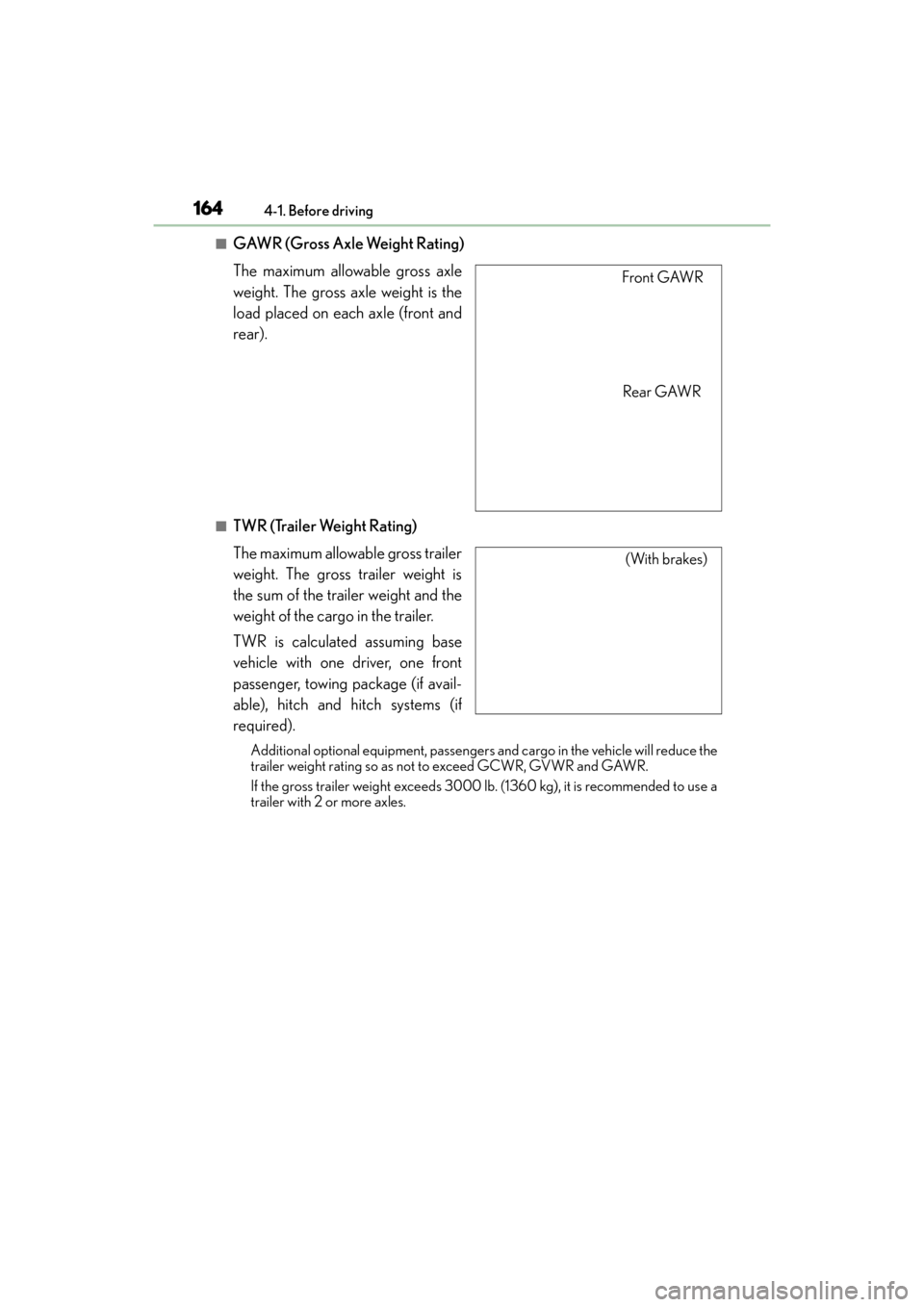
164
GX 460 _O M_ OM6 0K 80 U_ (U)4-1. Before driving
■GAWR (Gross Axle Weight Rating)
The maximum allowable gross axle
weight. The gross axle weight is the
load placed on each axle (front and
rear).
■TWR (Trailer Weight Rating)
The maximum allowable gross trailer
weight. The gross trailer weight is
the sum of the trailer weight and the
weight of the cargo in the trailer.
TWR is calculated assuming base
vehicle with one driver, one front
passenger, towing package (if avail-
able), hitch and hitch systems (if
required).
Additional optional equipment, passengers and cargo in the vehicle will reduce the
trailer weight rating so as not to exceed GCWR, GVWR and GAWR.
If the gross trailer weight exceeds 3000 lb
. (1360 kg), it is recommended to use a
trailer with 2 or more axles.
Front GAWR
Rear GAWR
(With brakes)
GX460_OM_OM60K80U_(U).book Page 164 Wednesday, July 3, 2013 11:40 AM
Page 167 of 624
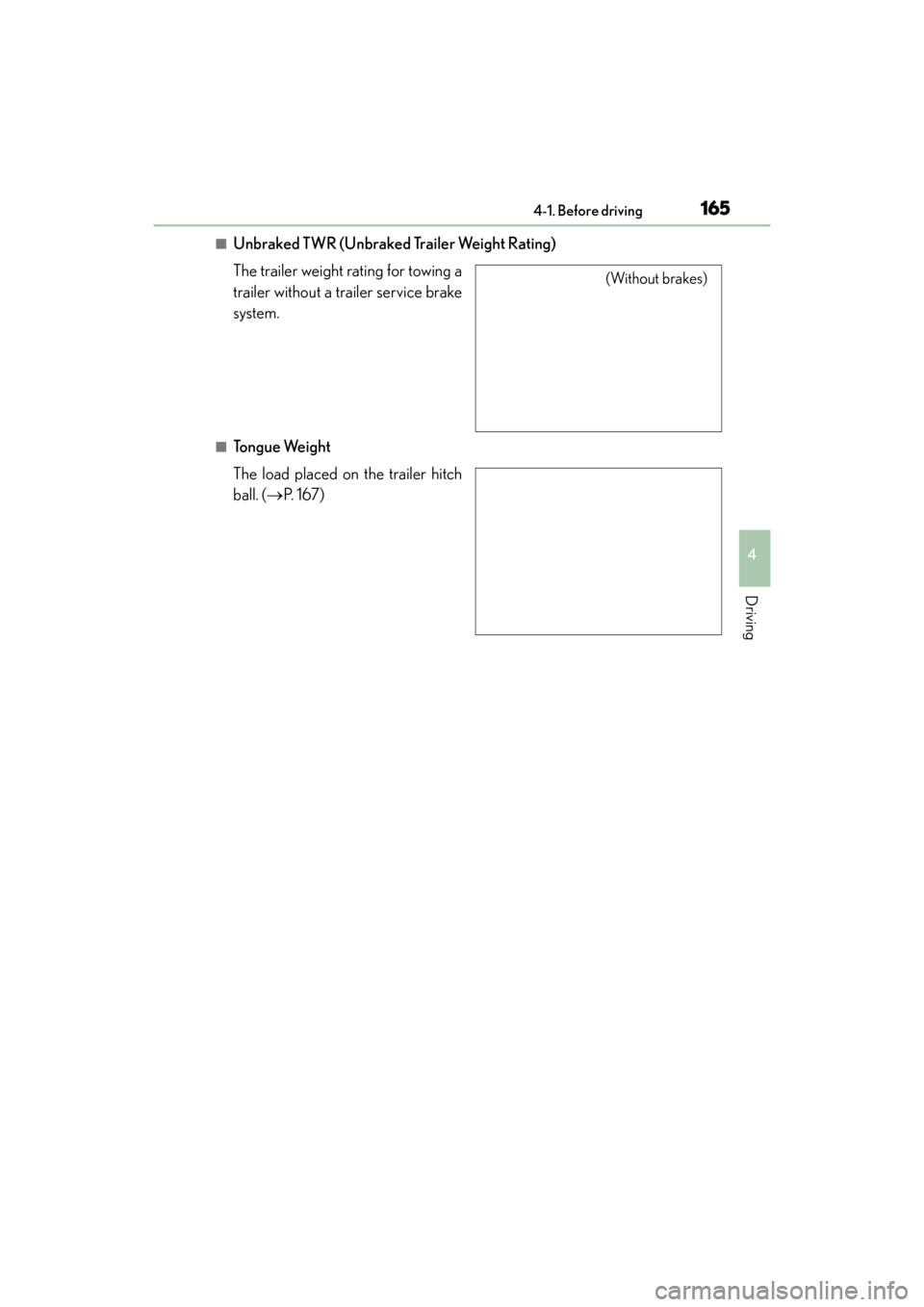
GX 460 _O M_ OM6 0K 80 U_ (U)
1654-1. Before driving
4
Driving
■Unbraked TWR (Unbraked Trailer Weight Rating)
The trailer weight rating for towing a
trailer without a trailer service brake
system.
■Tongue Weight
The load placed on the trailer hitch
ball. (→P. 1 6 7 )
(Without brakes)
GX460_OM_OM60K80U_(U).book Page 165 Wednesday, July 3, 2013 11:40 AM
Page 168 of 624
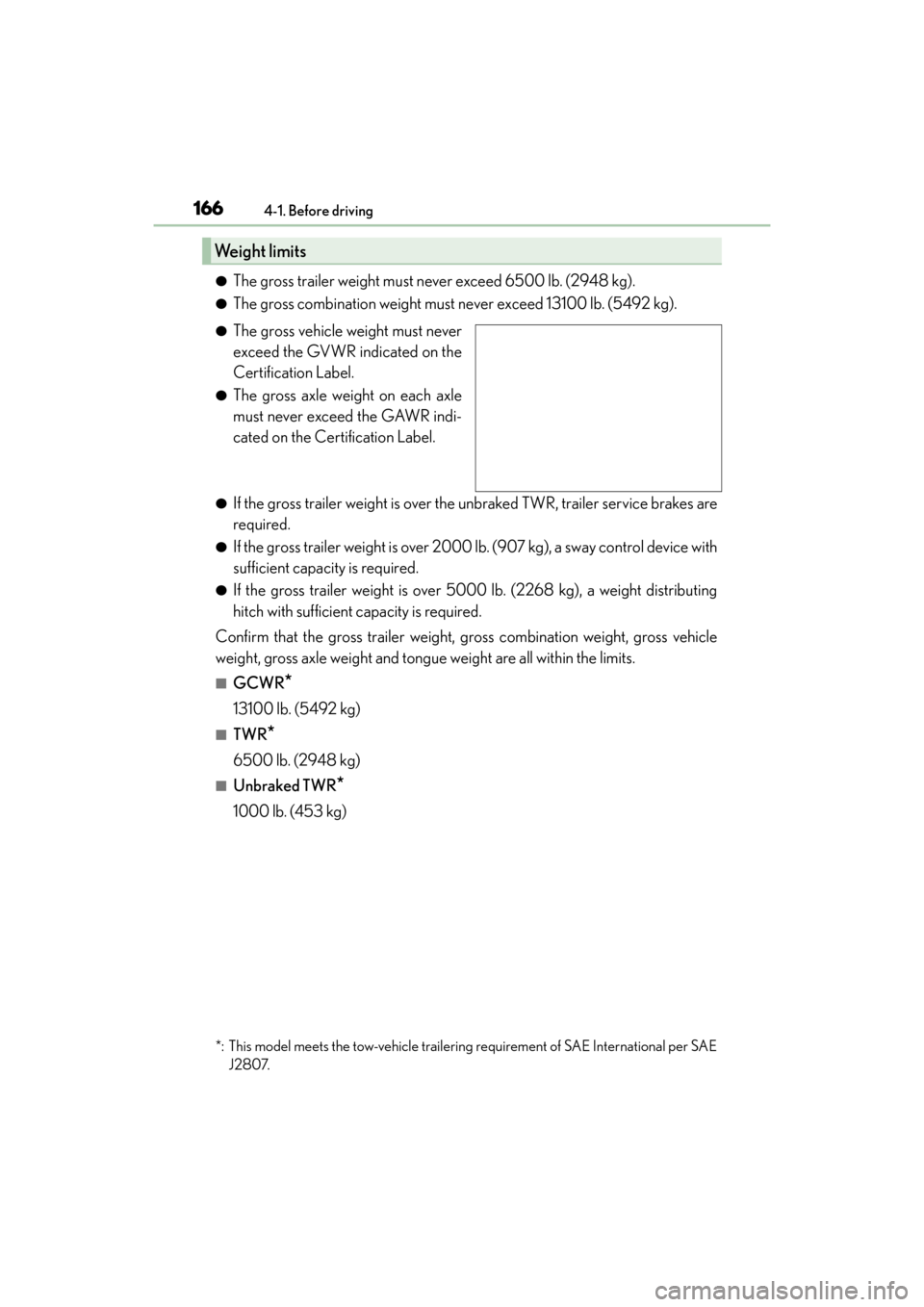
166
GX 460 _O M_ OM6 0K 80 U_ (U)4-1. Before driving
●The gross trailer weight must never exceed 6500 lb. (2948 kg).
●The gross combination weight must never exceed 13100 lb. (5492 kg).
●The gross vehicle weight must never
exceed the GVWR indicated on the
Certification Label.
●The gross axle weight on each axle
must never exceed the GAWR indi-
cated on the Certification Label.
●If the gross trailer weight is over the unbraked TWR, trailer service brakes are
required.
●If the gross trailer weight is over 2000 lb. (907 kg), a sway control device with
sufficient capacity is required.
●If the gross trailer weight is over 5000 lb. (2268 kg), a weight distributing
hitch with sufficient capacity is required.
Confirm that the gross trailer weight, gross combination weight, gross vehicle
weight, gross axle weight and tongue weight are all within the limits.
■GCWR*
13100 lb. (5492 kg)
■TWR*
6500 lb. (2948 kg)
■Unbraked TWR*
1000 lb. (453 kg)
Weight limits
*: This model meets the tow-vehicle trailering requirement of SAE International per SAE J2807.
GX460_OM_OM60K80U_(U).book Page 166 Wednesday, July 3, 2013 11:40 AM
Page 169 of 624
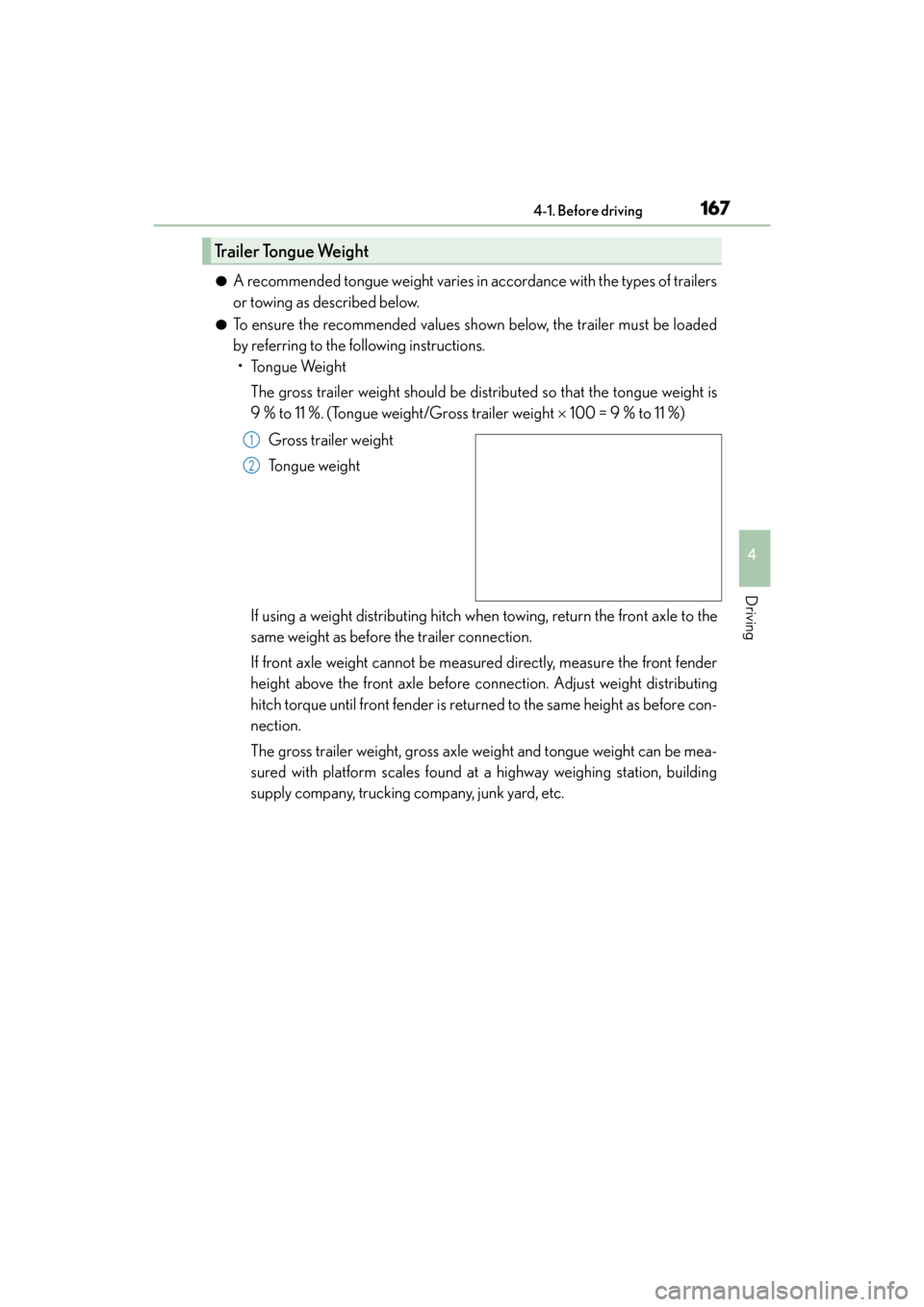
GX 460 _O M_ OM6 0K 80 U_ (U)
1674-1. Before driving
4
Driving
●A recommended tongue weight varies in accordance with the types of trailers
or towing as described below.
●To ensure the recommended values shown below, the trailer must be loaded
by referring to the following instructions.•Tongue Weight
The gross trailer weight should be distributed so that the tongue weight is
9 % to 11 %. (Tongue weight/Gross trailer weight × 100 = 9 % to 11 %)
Gross trailer weight
To n g u e w e i g h t
If using a weight distributing hitch when towing, return the front axle to the
same weight as before the trailer connection.
If front axle weight cannot be measured directly, measure the front fender
height above the front axle before connection. Adjust weight distributing
hitch torque until front fender is returned to the same height as before con-
nection.
The gross trailer weight, gross axle weight and tongue weight can be mea-
sured with platform scales found at a highway weighing station, building
supply company, trucking company, junk yard, etc.
Trailer Tongue Weight
1
2
GX460_OM_OM60K80U_(U).book Page 167 Wednesday, July 3, 2013 11:40 AM
Page 170 of 624
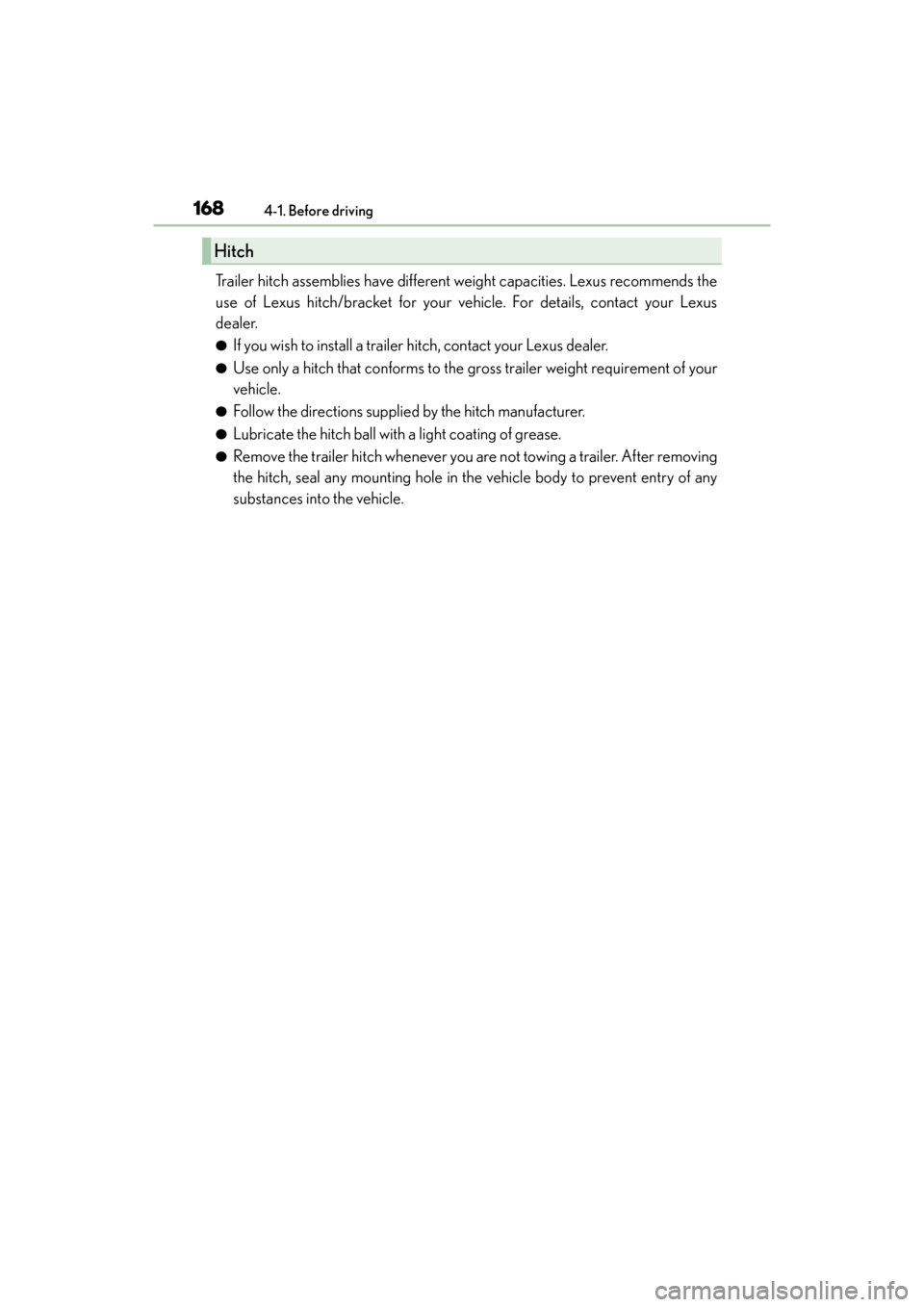
168
GX 460 _O M_ OM6 0K 80 U_ (U)4-1. Before driving
Trailer hitch assemblies have different weight capacities. Lexus recommends the
use of Lexus hitch/bracket for your vehicle. For details, contact your Lexus
dealer.
●If you wish to install a trailer hitch, contact your Lexus dealer.
●Use only a hitch that conforms to the gross trailer weight requirement of your
vehicle.
●Follow the directions supplied by the hitch manufacturer.
●Lubricate the hitch ball with a light coating of grease.
●Remove the trailer hitch whenever you are not towing a trailer. After removing
the hitch, seal any mounting hole in the vehicle body to prevent entry of any
substances into the vehicle.
Hitch
GX460_OM_OM60K80U_(U).book Page 168 Wednesday, July 3, 2013 11:40 AM
Page 172 of 624
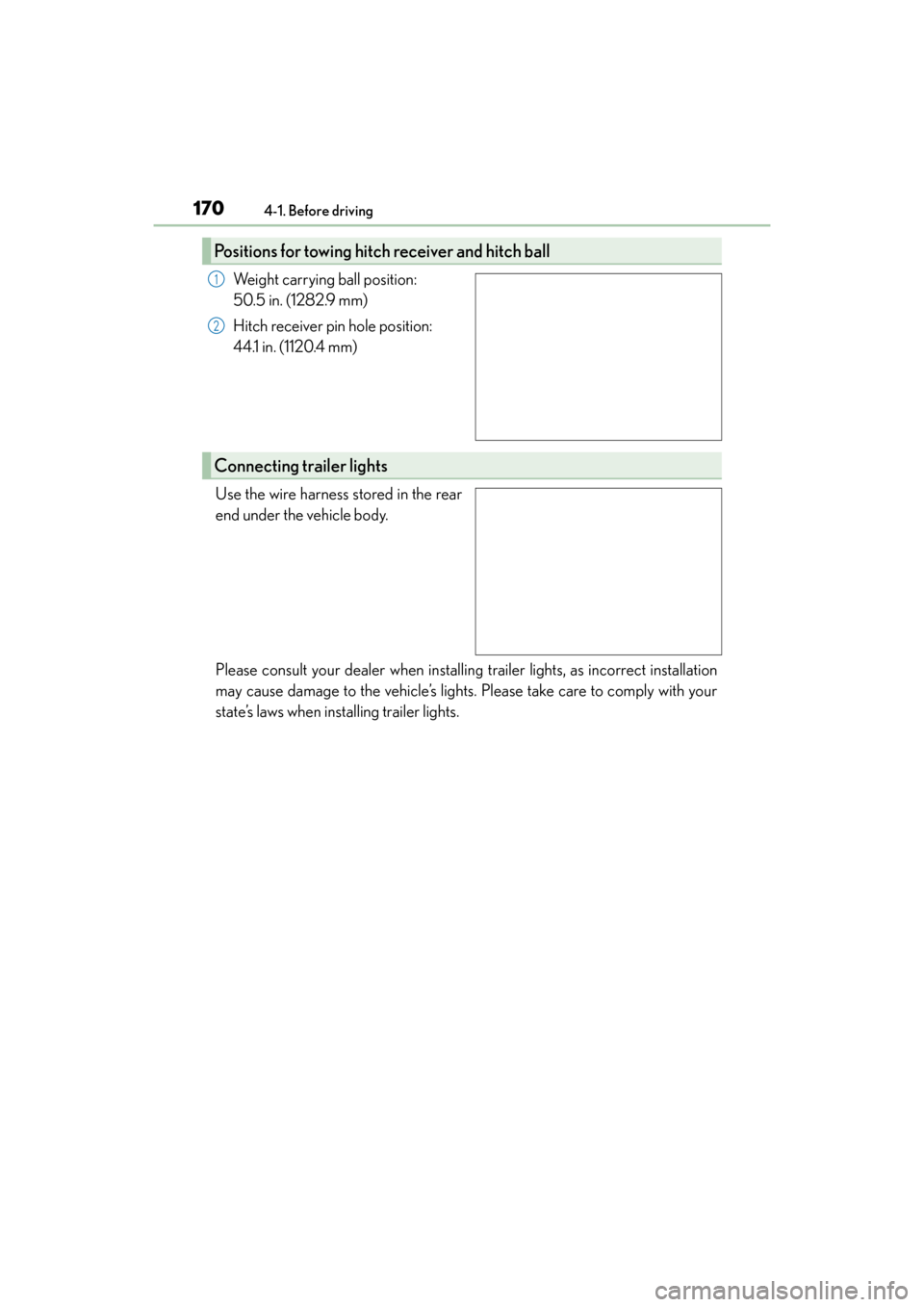
170
GX 460 _O M_ OM6 0K 80 U_ (U)4-1. Before driving
Weight carrying ball position:
50.5 in. (1282.9 mm)
Hitch receiver pin hole position:
44.1 in. (1120.4 mm)
Use the wire harness stored in the rear
end under the vehicle body.
Please consult your dealer when installing trailer lights, as incorrect installation
may cause damage to the vehicle’s lights. Please take care to comply with your
state’s laws when installing trailer lights.
Positions for towing hitch receiver and hitch ball
1
2
Connecting trailer lights
GX460_OM_OM60K80U_(U).book Page 170 Wednesday, July 3, 2013 11:40 AM
Page 174 of 624

172
GX 460 _O M_ OM6 0K 80 U_ (U)4-1. Before driving
Your vehicle will handle differently when towing a trailer. Help to avoid an acci-
dent, death or serious injury, keep the following in mind when towing:
●Speed limits for towing a trailer vary by state or province. Do not exceed the
posted towing speed limit.
●Lexus recommends that the vehicle-trailer speed limit is 65 mph (104 km/h)
on a flat, straight, dry road. Do not exceed this limit, the posted towing speed
limit or the speed limit for your trailer as set forth in your trailer owner’s man-
ual, whichever is lowest. Instability of the towing vehicle-trailer combination
(trailer sway) increases as speed increases. Exceeding speed limits may cause
loss of control.
●Before starting out, check the trailer lights, tires and the vehicle-trailer con-
nections. Recheck after driving a short distance.
●Practice turning, stopping and reversing with the trailer attached in an area
away from traffic until you become accustomed to the feel of the vehicle-
trailer combination.
●Reversing with a trailer attached is difficult and requires practice. Grip the
bottom of the steering wheel and move your hand to the left to move the
trailer to the left. Move your hand to the right to move the trailer to the right.
(This is generally opposite to reversing without a trailer attached.) Avoid sharp
or prolonged turning. Have
someone guide you when reversing to reduce the
risk of an accident.
●As stopping distance is increased when towing a trailer, vehicle-to-vehicle dis-
tance should be increased. For each 10 mph (16 km/h) of speed, allow at least
one vehicle and trailer length.
●Avoid sudden braking as you may skid, resulting in the trailer jackknifing and
loss of vehicle control. This is especially true on wet or slippery surfaces.
Trailer towing tips
GX460_OM_OM60K80U_(U).book Page 172 Wednesday, July 3, 2013 11:40 AM
Page 177 of 624
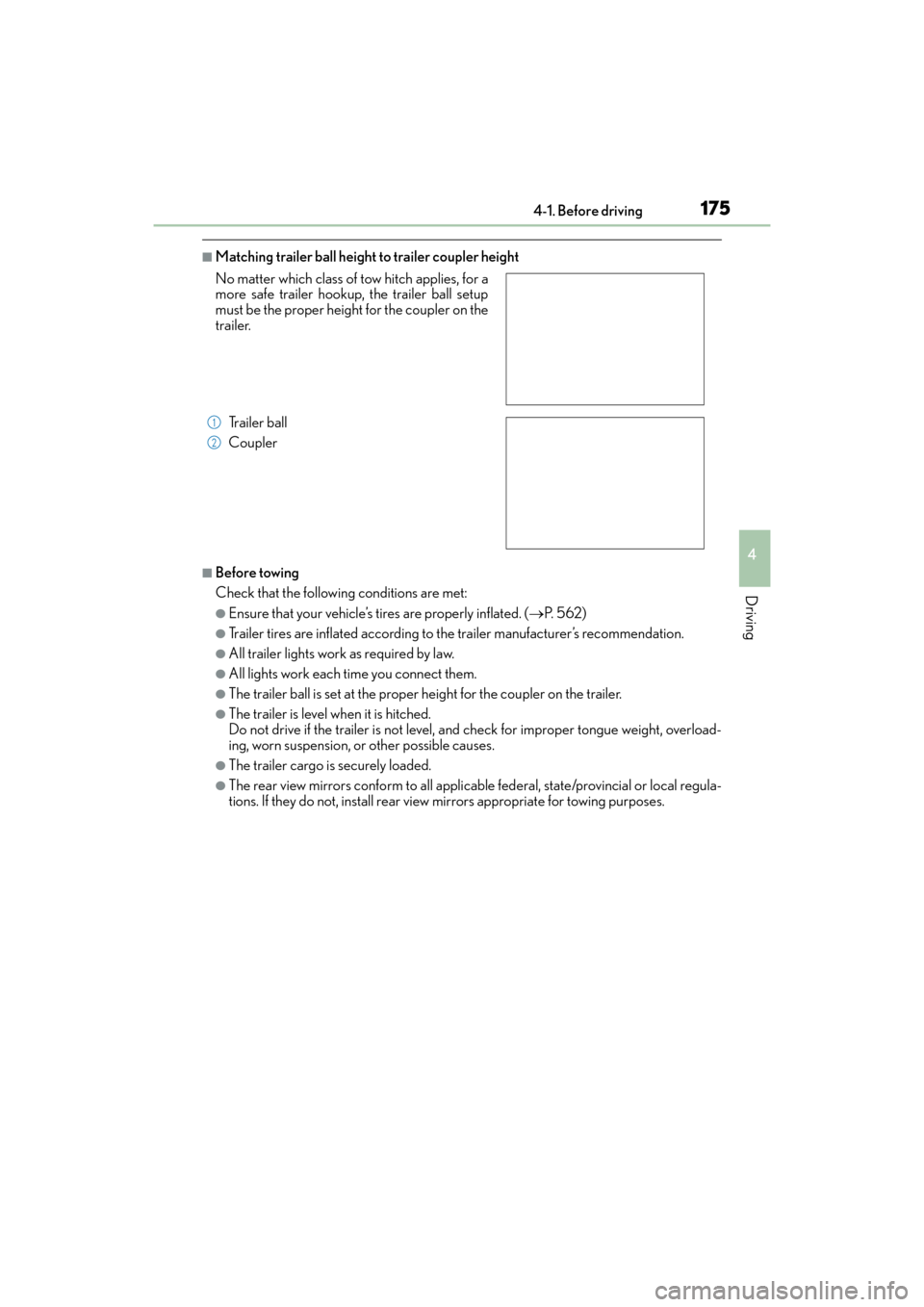
GX 460 _O M_ OM6 0K 80 U_ (U)
1754-1. Before driving
4
Driving
■Matching trailer ball height to trailer coupler height
■Before towing
Check that the following conditions are met:
●Ensure that your vehicle’s tires are properly inflated. (→P. 5 6 2 )
●Trailer tires are inflated according to the trailer manufacturer’s recommendation.
●All trailer lights work as required by law.
●All lights work each time you connect them.
●The trailer ball is set at the proper height for the coupler on the trailer.
●The trailer is level when it is hitched.
Do not drive if the trailer is not level, and check for improper tongue weight, overload-
ing, worn suspension, or other possible causes.
●The trailer cargo is securely loaded.
●The rear view mirrors conform to all applicable federal, state/provincial or local regula-
tions. If they do not, install rear view mirrors appropriate for towing purposes.
No matter which class of tow hitch applies, for a
more safe trailer hookup, the trailer ball setup
must be the proper height for the coupler on the
trailer.
Trailer ball
Coupler
1
2
GX460_OM_OM60K80U_(U).book Page 175 Wednesday, July 3, 2013 11:40 AM
Page 178 of 624

176
GX 460 _O M_ OM6 0K 80 U_ (U)4-1. Before driving
■AVS (adaptive variable suspension system)
The suspension can be switched fo
r improvement in driveability. (→P. 331)
■Break-in schedule
If your vehicle is new or equipped with any new power train components (such as an
engine, transmission, differential or wheel bearing), Lexus recommends that you do not
tow a trailer until the vehicle has been driven for over 500 miles (800 km).
After the vehicle has been driven for over 500 miles (800 km), you can start towing.
However, for the next 500 miles (800 km), drive the vehicle at a speed of less than
50 mph (80 km/h) when towing a trailer, and avoid full throttle acceleration.
■Maintenance
●If you tow a trailer, your vehicle will require more frequent maintenance due to the addi-
tional load. (See “Owner’s Guide”, “Warranty and Services Guide”, “Owner’s Manual
Supplement” or “Warranty Booklet”.)
●Retighten the fixing bolts of the towing ball and bracket after approximately 600 miles
(1000 km) of trailer towing.
■If trailer sway occurs
One or more factors (crosswinds, passing vehicles, rough roads, etc.) can adversely
affect handling of your vehicle and trailer, causing instability.
●If trailer swaying occurs:
• Firmly grip the steering wheel. Steer straight ahead.
Do not try to control trailer swaying by turning the steering wheel.
• Begin releasing the accelerator pedal immediately but very gradually to reduce speed.
Do not increase speed. Do not apply vehicle brakes.
If you make no extreme correction with the steering or brakes, your vehicle and trailer
should stabilize.
GX460_OM_OM60K80U_(U).book Page 176 Wednesday, July 3, 2013 11:40 AM